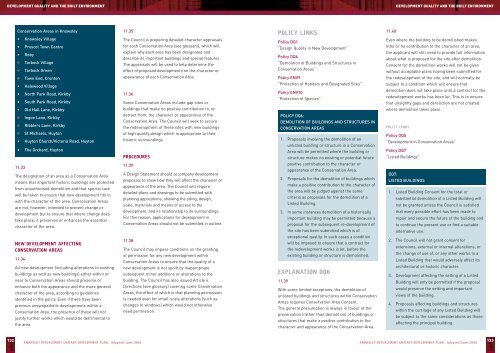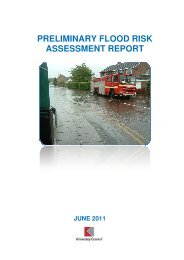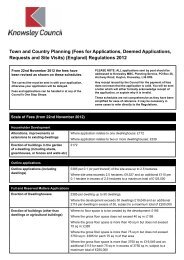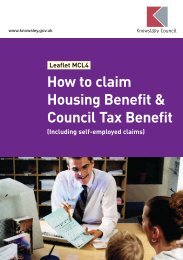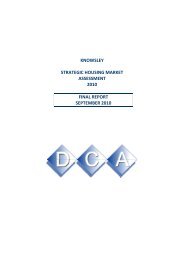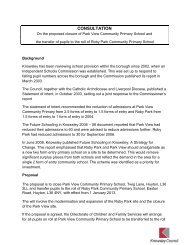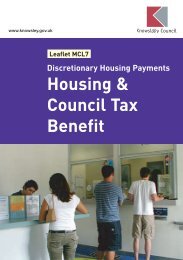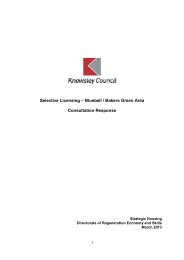Knowsley Replacement Unitary Development Plan - Knowsley Council
Knowsley Replacement Unitary Development Plan - Knowsley Council
Knowsley Replacement Unitary Development Plan - Knowsley Council
Create successful ePaper yourself
Turn your PDF publications into a flip-book with our unique Google optimized e-Paper software.
DEVELOPMENT QUALITY AND THE BUILT ENVIRONMENT<br />
DEVELOPMENT QUALITY AND THE BUILT ENVIRONMENT<br />
Conservation Areas in <strong>Knowsley</strong><br />
• <strong>Knowsley</strong> Village<br />
• Prescot Town Centre<br />
• Roby<br />
• Tarbock Village<br />
• Tarbock Green<br />
• Town End, Cronton<br />
• Halewood Village<br />
• North Park Road, Kirkby<br />
• South Park Road, Kirkby<br />
• Old Hall Lane, Kirkby<br />
• Ingoe Lane, Kirkby<br />
• Ribblers Lane, Kirkby<br />
• St Michaels, Huyton<br />
• Huyton Church/Victoria Road, Huyton<br />
• The Orchard, Huyton<br />
11.33<br />
The designation of an area as a Conservation Area<br />
means that important historic buildings are protected<br />
from unauthorised demolition and that special care<br />
will be taken to ensure that new development fits in<br />
with the character of the area. Conservation Areas<br />
are not, however, intended to prevent change or<br />
development but to ensure that where change does<br />
take place, it preserves or enhances the essential<br />
character of the area.<br />
NEW DEVELOPMENT AFFECTING<br />
CONSERVATION AREAS<br />
11.34<br />
All new development (including alterations to existing<br />
buildings as well as new buildings) either within or<br />
near to Conservation Areas should preserve or<br />
enhance both the appearance and the more general<br />
character of the area, according to guidelines<br />
identified in the policy. Even if there have been<br />
previous unsympathetic developments within a<br />
Conservation Area, the presence of these will not<br />
justify further works which would be detrimental to<br />
the area.<br />
11.35<br />
The <strong>Council</strong> is preparing detailed character appraisals<br />
for each Conservation Area (see glossary), which will<br />
explain why each area has been designated and<br />
describe its important buildings and special features.<br />
The appraisals will be used to help determine the<br />
effect of proposed developments on the character or<br />
appearance of each Conservation Area.<br />
11.36<br />
Some Conservation Areas include gap sites or<br />
buildings that make no positive contribution to, or<br />
detract from, the character or appearance of the<br />
Conservation Area. The <strong>Council</strong> will seek to secure<br />
the redevelopment of these sites with new buildings<br />
of high quality design which is appropriate to their<br />
historic surroundings.<br />
PROCEDURES<br />
11.37<br />
A Design Statement should accompany development<br />
proposals to show how they will affect the character or<br />
appearance of the area. The <strong>Council</strong> will require<br />
detailed plans and drawings to be submitted with<br />
planning applications, showing the siting, design,<br />
scale, materials and means of access to the<br />
development, and its relationship to its surroundings.<br />
For this reason, applications for development in<br />
Conservation Areas should not be submitted in outline.<br />
11.38<br />
The <strong>Council</strong> may impose conditions on the granting<br />
of permission for any new development within<br />
Conservation Areas to ensure that the quality of a<br />
new development is not spoilt by inappropriate<br />
subsequent minor additions or alterations to the<br />
building. The <strong>Council</strong> has also issued Article 4<br />
Directions (see glossary) covering some Conservation<br />
Areas, the effect of which is that planning permission<br />
is needed even for small-scale alterations (such as<br />
changes to windows) which would not otherwise<br />
need permission.<br />
POLICY LINKS<br />
Policy DQ1<br />
“Design Quality in New <strong>Development</strong>”<br />
Policy DQ6<br />
“Demolition of Buildings and Structures in<br />
Conservation Areas”<br />
Policy ENV9<br />
“Protection of Habitats and Designated Sites”<br />
Policy ENV10<br />
“Protection of Species”<br />
POLICY DQ6:<br />
DEMOLITION OF BUILDINGS AND STRUCTURES IN<br />
CONSERVATION AREAS<br />
1. Proposals involving the demolition of an<br />
unlisted building or structure in a Conservation<br />
Area will be permitted where the building or<br />
structure makes no existing or potential future<br />
positive contribution to the character or<br />
appearance of the Conservation Area.<br />
2. Proposals for the demolition of buildings which<br />
make a positive contribution to the character of<br />
the area will be judged against the same<br />
criteria as proposals for the demolition of a<br />
Listed Building.<br />
3. In some instances demolition of a historically<br />
important building may be permitted because a<br />
proposal for the subsequent re-development of<br />
the site has been submitted which is of<br />
exceptional quality. In such cases a condition<br />
will be imposed to ensure that a contract for<br />
the redevelopment works is let, before the<br />
existing building or structure is demolished.<br />
EXPLANATION DQ6<br />
11.39<br />
With some limited exceptions, the demolition of<br />
unlisted buildings and structures within Conservation<br />
Areas requires Conservation Area Consent.<br />
The general presumption is always in favour of the<br />
preservation (rather than demolition) of buildings or<br />
structures that make a positive contribution to the<br />
character and appearance of the Conservation Area.<br />
11.40<br />
Even where the building to be demolished makes<br />
little or no contribution to the character of an area,<br />
the applicant will still need to provide full information<br />
about what is proposed for the site after demolition.<br />
Consent for the demolition works will not be given<br />
without acceptable plans having been submitted for<br />
the redevelopment of the site, and will normally be<br />
subject to a condition which will ensure that<br />
demolition does not take place until a contract for the<br />
redevelopment works has been let. This is to ensure<br />
that unsightly gaps and dereliction are not created<br />
where demolition takes place.<br />
POLICY LINKS<br />
Policy DQ5<br />
“<strong>Development</strong> in Conservation Areas”<br />
Policy DQ7<br />
“Listed Buildings”<br />
DQ7:<br />
LISTED BUILDINGS<br />
1. Listed Building Consent for the total or<br />
substantial demolition of a Listed Building will<br />
not be granted unless the <strong>Council</strong> is satisfied<br />
that every possible effort has been made to<br />
repair and secure the future of the building and<br />
to continue the present use or find a suitable<br />
alternative use.<br />
2. The <strong>Council</strong> will not grant consent for<br />
extensions, external or internal alterations, or<br />
the change of use of, or any other works to a<br />
Listed Building that would adversely affect its<br />
architectural or historic character.<br />
3. <strong>Development</strong> affecting the setting of a Listed<br />
Building will only be permitted if the proposal<br />
would preserve the setting and important<br />
views of the building.<br />
4. Proposals affecting buildings and structures<br />
within the curtilage of any Listed Building will<br />
be subject to the same considerations as those<br />
affecting the principal building.<br />
132<br />
KNOWSLEY REPLACEMENT UNITARY DEVELOPMENT PLAN: Adopted June 2006<br />
KNOWSLEY REPLACEMENT UNITARY DEVELOPMENT PLAN: Adopted June 2006<br />
133


